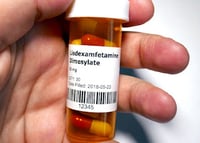CBT Plus Lisdexamfetamine Dramatically Reduces Binge-Eating Episodes, AJP Study Finds

“The superiority of the combined … approach might reflect, in part, complementary and synergistic effect of the two treatments,” wrote Carlos M. Grilo, Ph.D., of Yale University School of Medicine, and colleagues. “CBT and LDX likely operate via distinct mechanisms (the former via reducing unhealthy restraint and unstructured eating and addressing the core body-image disturbance and the later via eating regulation and reward effects and reduced impulsivity) and one can speculate that some of the LDX effects on improving executive functioning might enhance ability to derive greater benefit from CBT.”
Grilo and colleagues enrolled 141 adults ages 18 to 64 (83.7% women) with binge-eating disorder and comorbid obesity. The participants were equally divided into one of three treatment arms for 12 weeks: CBT only, LDX only (target dose of 50 to 70 mg/day), or CBT+LDX. The CBT involved 12 weekly 60-minute sessions and focused on helping individuals identify maladaptive eating thoughts and behaviors and work toward normalized eating patterns.
After 12 weeks, participants who received CBT+LDX reported a 96.1% decrease in the frequency of binge-eating episodes in the past 28 days; further, 70.2% of participants achieved remission (zero binge-eating episodes in the past 28 days). Patients in the CBT and LDX groups also reported significant binge-eating declines, although only 44.7% and 40.4%, respectively, achieved remission.
In terms of weight loss, those receiving CBT+LDX or LDX lost an average of 4.8% and 5.5% of their baseline body weight, respectively, while those receiving only CBT lost 0.5% of their baseline weight.
For related information, see the American Journal of Psychiatry study “Naltrexone-Bupropion and Behavior Therapy, Alone and Combined, for Binge-Eating Disorder: Randomized Double-Blind Placebo-Controlled Trial.”
(Image: Getty Images/iStock/Hailshadow)
Don't miss out! To learn about newly posted articles in Psychiatric News, please sign up here.





